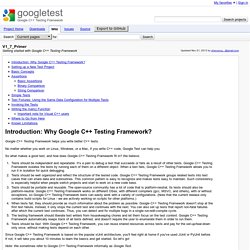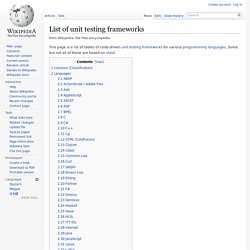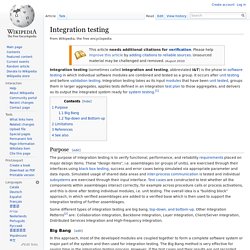

Mocks Aren't Stubs. The term 'Mock Objects' has become a popular one to describe special case objects that mimic real objects for testing.

Most language environments now have frameworks that make it easy to create mock objects. What's often not realized, however, is that mock objects are but one form of special case test object, one that enables a different style of testing. In this article I'll explain how mock objects work, how they encourage testing based on behavior verification, and how the community around them uses them to develop a different style of testing.
I first came across the term "mock object" a few years ago in the Extreme Programming (XP) community. Since then I've run into mock objects more and more. But as often as not I see mock objects described poorly. This difference is actually two separate differences. Regular Tests I'll begin by illustrating the two styles with a simple example. These two behaviors imply a couple of tests, these look like pretty conventional JUnit tests. CookBook - googlemock - Google C++ Mocking Framework Cookbook - Google C++ Mocking Framework. You can find recipes for using Google Mock here.

If you haven't yet, please read the ForDummies document first to make sure you understand the basics. Note: Google Mock lives in the testing name space. For readability, it is recommended to write using ::testing::Foo; once in your file before using the name Foo defined by Google Mock. We omit such using statements in this page for brevity, but you should do it in your own code. Mocking Private or Protected Methods You must always put a mock method definition (MOCK_METHOD*) in a public: section of the mock class, regardless of the method being mocked being public, protected, or private in the base class. Class Foo { public: ... virtual bool Transform(Gadget* g) = 0; protected: virtual void Resume(); private: virtual int GetTimeOut();}; class MockFoo : public Foo { public: ... // The following must be in the public section, even though the // methods are protected or private in the base class.
CookBook - googlemock - Google C++ Mocking Framework Cookbook - Google C++ Mocking Framework. V1_7_Primer - googletest - Getting started with Google C++ Testing Framework - Google C++ Testing Framework. Google C++ Testing Framework helps you write better C++ tests.

No matter whether you work on Linux, Windows, or a Mac, if you write C++ code, Google Test can help you. So what makes a good test, and how does Google C++ Testing Framework fit in? We believe: Tests should be independent and repeatable. List of unit testing frameworks. This page is a list of tables of code-driven unit testing frameworks for various programming languages.

Some but not all of these are based on xUnit. Columns (Classification)[edit] Name: This column contains the name of the framework and will usually link to it.xUnit: This column indicates whether a framework should be considered of xUnit type.TAP: This column indicates whether a framework can emit TAP output for TAP-compliant testing harnesses.Generators: Indicates whether a framework supports data generators. Data generators generate input data for a test and the test is run for each input data that the generator produces.Fixtures: Indicates whether a framework supports test-local fixtures. Jennifersmith/plasma. Aharin/inproctester. Integration testing. Purpose[edit] The purpose of integration testing is to verify functional, performance, and reliability requirements placed on major design items.

These "design items", i.e. assemblages (or groups of units), are exercised through their interfaces using black box testing, success and error cases being simulated via appropriate parameter and data inputs. Simulated usage of shared data areas and inter-process communication is tested and individual subsystems are exercised through their input interface. Test cases are constructed to test whether all the components within assemblages interact correctly, for example across procedure calls or process activations, and this is done after testing individual modules, i.e. unit testing. The overall idea is a "building block" approach, in which verified assemblages are added to a verified base which is then used to support the integration testing of further assemblages. Big Bang[edit] What is Integration Testing? - Definition from Techopedia.
Citrus Framework. Comparison of c++ unit test frameworks. Modern C++ Testing - level of indirection - level of indirection. Back in August I took my family to stay for a week at my brother's house in (Old) South Wales.

I've not been to Wales for a long time and it was great to be back there - but that's not what this post is about, of course. The thing about Wales is that it has mountains (and where there are no mountains there are plenty of hills and valleys and cliffs). Mobile cell coverage is non-existent in much of the country - particularly where my brother lives. So the timing was particularly bad when, just as we were driving along the south cost (somewhere between Cardiff and Swansea, I think), I started getting emails and tweets from people pointing out that Catch was riding high on HackerNews!
Someone had recently discovered Catch and was enjoying it enough that they wanted to share it with the community. Except that, between lack of mobile reception and spending time with my family, I didn't have opportunity to join the discussion. When I got back home a week later I read through the comments.